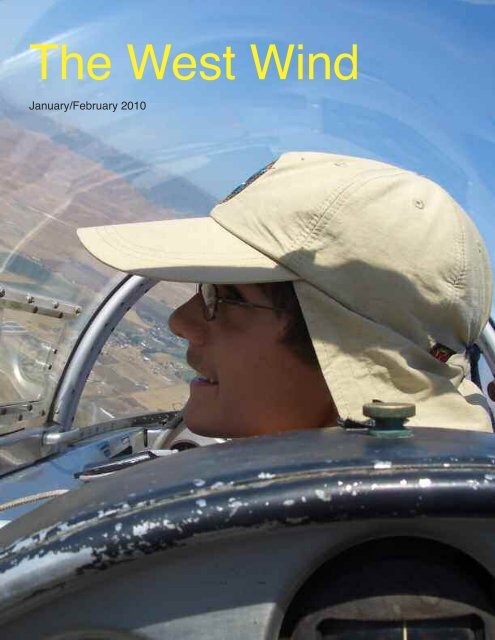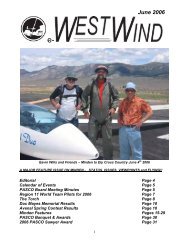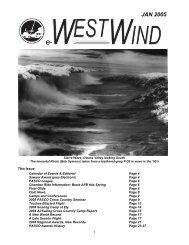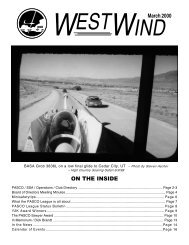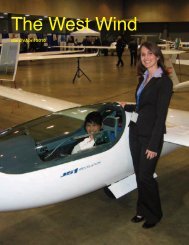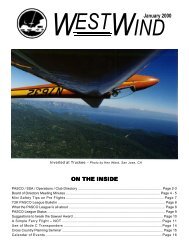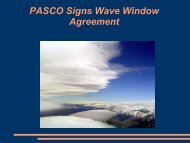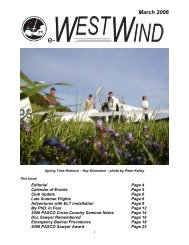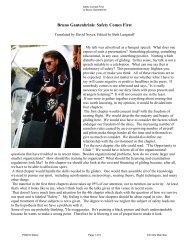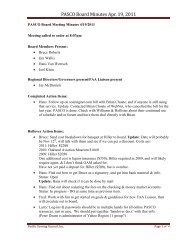10 - 1 The West Wind - Pacific Soaring Council
10 - 1 The West Wind - Pacific Soaring Council
10 - 1 The West Wind - Pacific Soaring Council
You also want an ePaper? Increase the reach of your titles
YUMPU automatically turns print PDFs into web optimized ePapers that Google loves.
<strong>The</strong> <strong>West</strong> <strong>Wind</strong><br />
January/February 20<strong>10</strong>
Preflight<br />
My bagpipe instructor once cautioned me against<br />
apologizing before playing a tune. However, since<br />
there have been a few changes to <strong>The</strong> <strong>West</strong> <strong>Wind</strong><br />
magazine, I feel an explanation is in order: Last Fall<br />
I volunteered to help out on the PASCO board and<br />
agreed to take a shot at editing <strong>The</strong> <strong>West</strong> <strong>Wind</strong>. My<br />
initial motivation was purely selfish – I felt that the<br />
responsibility would remind me to go soaring!<br />
Once I started working with the PASCO board members,<br />
however, I was quickly struck by their professionalism<br />
and dedication. Although entirely<br />
volunteer, the PASCO board and a number of supporting<br />
cast are diligently working to promote the<br />
sport of soaring in a variety of ways - which I hope to<br />
describe in this magazine. <strong>The</strong>y – and you – are also<br />
simply a fantastic group of people. I am delighted to<br />
contribute in this small way.<br />
Editing a magazine is a new experience for me – I<br />
have never played this tune! However I am determined<br />
to give it a try; to experiment, to illustrate, to<br />
describe. Even, occasionally, to fake it. But above<br />
all, I will be having fun. I hope you find it fun to<br />
read. Let’s go soaring on <strong>The</strong> <strong>West</strong> <strong>Wind</strong>!<br />
In this issue I report on some things that have come<br />
up at PASCO Board meetings over the past few<br />
months and the Fall PASCO Seminar (wow!) We get<br />
news from the Northern California <strong>Soaring</strong> Association<br />
and a delightful trip report from Morteza Ansari.<br />
Fred LaSor briefs us on PASCO’s recent work with<br />
the FAA. - Jim Wallis, Editor<br />
Cover: John Pericich thermaling over Byron in NCSA’s<br />
Blanik L-13<br />
Heard Around the Airport<br />
Licenses<br />
OK. Take out your pilots license and look at it. Is it<br />
made of paper? If it is, you need to replace it with a<br />
plastic one by 31 March, 20<strong>10</strong> or you won’t be street<br />
legal. I know, I know. I don’t like change either. But<br />
this new license is cool: On the front, it has a picture<br />
of a Wright Flyer racing what looks like a 737. On<br />
the back, a photo of the brothers themselves. Did<br />
they ever get a license? Doubt it. But you need one,<br />
so do this. <strong>The</strong>n go soaring.<br />
Next SSA Convention<br />
Wow! <strong>The</strong> next SSA convention is going to be in Reno<br />
in 2012. We haven’t hosted one of these in a while.<br />
Stay tuned for additional information. I just got back<br />
from the SSA convention in Little Rock – what a blast<br />
(details in the next issue).<br />
PASCO Hats and t-shirts<br />
What is the well dressed soaring pilot or crew wearing?<br />
Glad you asked. Check out our Spring fashion<br />
line-up of PASCO hats and t-shirts. <strong>The</strong>se are de<br />
rigueur wherever soaring pilots congregate, are available<br />
now and selling fast. Contact Joel Klein at<br />
joel@klein-graphics.com.<br />
Previously owned transponder<br />
Fred has a Becker Mode-C transponder with<br />
wiring harness, altitude encoder and antenna —<br />
ready to put into your glider so you can be seen by air<br />
carriers and others with TCAS. Great investment in<br />
safety. He only has one right now, but will sell the<br />
whole thing for $1,950. Give Fred a call at 775-790-<br />
4314.
PASCO Safety Seminar<br />
and Banquet<br />
I had never been to a PASCO Seminar before so I was<br />
looking forward to attending. It was doubly interesting<br />
because the seminar was held at the Hiller Aviation<br />
Museum located at the San Carlos airport.<br />
Arriving early so I could help set up chairs, I also<br />
grabbed a choice seat near the front.<br />
<strong>The</strong> first speaker was Richard Pearl on glider<br />
safety. Richard opened by expressing some of the<br />
frustration we probably all feel: Why do the same accidents<br />
keep happening? Richard did a good job organizing<br />
the accident record into something digestible<br />
– 52 incidents in the past two years! One thing that<br />
seemed to jump out at several attendees was the<br />
seemingly large number of accidents involving motor<br />
gliders.<br />
<strong>The</strong> underlying problem seems to be that the nature<br />
of soaring involves a lot of temptations for glider pilots<br />
to push the envelope. Richard pointed out that<br />
65% of the accidents involved pilots with “high time”<br />
(> 200 hours) so it appears that experience may not<br />
necessarily inoculate us against trouble.<br />
That was followed by an informative discussion about<br />
oxygen use. I didn’t know that the time taken to get<br />
to altitude could play a big role in acclimatization:<br />
Hiking to 14,000 feet over a day or two can yield a<br />
completely different result than going to altitude in<br />
just an hour. <strong>The</strong> faster you go up, the more rapid<br />
the onset of altitude effects. Also, altitude effects are<br />
cumulative, and can be aggravated by alcohol use.<br />
(Hopefully THIS isn’t an issue for pilots!)<br />
Altitude effects start coming on by about <strong>10</strong>,000 and<br />
there is about a <strong>10</strong>% decrease in coordination by<br />
12,000, and it is off 25% at 15,000. By 18,000 feet you<br />
typically have only about 30 minutes before you are<br />
unconscious! So, if there is any question, just go on<br />
oxygen at <strong>10</strong>,000. When at altitude, oxygen delivery<br />
is a critical aircraft system so it is particularly important<br />
to make sure the system is working and that it is<br />
appropriate for both the pilot and for the flight being<br />
contemplated. Otherwise, maintain currency. Exercise<br />
caution and be sure to plan your flights. Always<br />
be careful of your assumptions and work hard to<br />
maintain situational awareness.<br />
Fred LaSor was up next with a review of the Minden<br />
Wave. Since wave is a stable air phenomena,<br />
the best months for wave tend to be colder ones: January,<br />
March and April. But June seems to be a good<br />
month as well. Other important factors include wind<br />
within 45° of perpendicular to the ridge line and occurrence<br />
within about 25 miles of the ridge top.<br />
Wave is typically a pre-frontal phenomena so be sure<br />
to consider the potential complications of moisture<br />
and visibility. Where there is wave, there is a rotor<br />
underneath. Tighten your seatbelt and turn on that<br />
oxygen! <strong>The</strong> rotor can be your elevator up and down<br />
from the wave. Understand how it works, and the<br />
rotor can be your friend.<br />
Fred then gave us an overview of the “wave window”<br />
– procedures that have been developed in collaboration<br />
with the FAA which permit VFR glider flights to<br />
FL 280. This requires collaboration with a Wave<br />
<strong>Wind</strong>ow Operations Manager on the ground.<br />
June to September is a good time for thermals at<br />
Minden. <strong>The</strong>rmals are unstable air caused by warm<br />
ground under cold air. <strong>The</strong>rmals can be broken up by<br />
wind or wave. Good places to look for thermals are at<br />
“discontinuity” in the ground topography such as<br />
ridges.<br />
Many long distance flights can routinely be made<br />
from Minden including flights to the White Mountains<br />
or Susanville and returning. Kind of makes you<br />
want to head over there and do some flying!<br />
Next Pete Alexander made us all green with envy<br />
when he described his experiences soaring in New<br />
Zealand. What can you say about taking a vacation<br />
where you wake up every day and go flying? Peter<br />
brought a ton of pictures and has a delightful speaking<br />
style. All we had to do was dream! Boy, the terrain<br />
in the photos was rugged. Apparently there are<br />
little airstrips scattered all over. <strong>The</strong> trick is knowing<br />
where they are if you start getting low…<br />
Seminar - page 6<br />
Contributions<br />
<strong>The</strong> <strong>West</strong> <strong>Wind</strong> Magazine is interested in articles<br />
and/or photographs that are of general interest and<br />
related to almost anything to do with soaring including<br />
but not limited to: soaring techniques, safety,<br />
“how to”, “how not to”, “yeah, I did that”, “been there<br />
done that”, harmless gossip, hangar flying, good<br />
jokes, funny stories, quips, tips, quotes, hints, instructions,<br />
announcements, etc. Please submit material<br />
to the editor via electronic mail to<br />
Comm@<strong>Pacific</strong><strong>Soaring</strong>.org.
End of the Season<br />
Flights<br />
By Morteza Ansari<br />
<strong>The</strong> last soaring season was pretty<br />
slow for me. Between a new job, a couple of family<br />
vacations, and a few weekends with poor weather<br />
condition, I flew about half as much as usual. I was<br />
itching to get another couple of flights before the end<br />
of the season. Fortunately the weather god finally<br />
had mercy and the forecast for the end of the week<br />
was looking good, but with conditions weakening by<br />
Sunday. A quick chat with my boss and I had Friday<br />
off (I owe him one) and on Thursday night I headed to<br />
Minden.<br />
As usual I got a late start (between a work conference<br />
call and everyone being busy launching) and didn’t<br />
get launched until close to 1PM. It was pretty quick<br />
to get to Paterson, but the really nice looking cloud<br />
street wasn’t working and I ended up low and looking<br />
for lift. After wasting a good chunk of time there, I<br />
was high again and the rest of the flight was very<br />
easy. I stayed between 15-18K the rest of the day.<br />
By the time I got close to Bishop, it was time to head<br />
back north. Just north of Mono lake I climbed back<br />
to 17.5K and it was time to decide which way to go.<br />
Over the Sierras it was pretty dark with lots of virga.<br />
To the east, someone was reporting getting low near<br />
Hilton ranch, and the direct line back to Minden was<br />
through a line of OD and virga. Given I knew the<br />
lines to the <strong>West</strong> and East weren’t working, I just<br />
headed directly for Minden. To my pleasant surprise,<br />
the air was friendly and I arrived at Minden at over<br />
12K, even though I was flying in snow and occasional<br />
hail for a good 5 minutes. Not bad for a short September<br />
day with a late start...<br />
<strong>The</strong> next day started with lots of moisture and by <strong>10</strong><br />
am you could see virga to the west and south of airport.<br />
I launched around 12:30 and by the time I<br />
reached the Pine Nuts they were pretty much covered<br />
by OD with some lightning just to the south. From<br />
Mt. Siegel south all was in shadows and looking<br />
pretty bad, but the clouds over the Pine Nuts were<br />
working.<br />
I got to about 17K and headed north to explore in<br />
that direction. Dayton Valley was in sunlight, but<br />
there wasn’t anything workable there. By then the<br />
whole Minden valley was covered in OD. Blue sky<br />
with some high clouds to the east, and thunderstorms<br />
to the south. I headed back toward Minden just to hit<br />
very strong sink and severe turbulence. After talking<br />
to Minden ground, I decided I’d rather land out than<br />
go back and land at Minden! I headed east after<br />
CANOPIES that block 98% all the UVA &<br />
UVB in clear or tint, enhance colors, improve<br />
definition, protect against sunburn, skin cancer,<br />
lower the cockpit temperature 15-20 degrees,<br />
and meet or exceed OEM standards.<br />
By <strong>The</strong>rmoTecUSA / Ray Poquette (6G) the<br />
leader in Canopy mfg. Upgrade your canopy<br />
now, and be a cool comfortable pilot. Some<br />
Canopies in stock. or 530.272.2556
hearing Matt had a thermal that took him to 16K,<br />
but couldn’t connect with it. In the mean time the<br />
squall line was moving east fast. I couldn’t even see<br />
Dayton anymore and in a few minutes Rabbit dry<br />
lake was also completely covered. I decided now was<br />
my chance and dove for Silver Springs airport. By<br />
the time I was on base, the AWOS was going off with<br />
wind shear advisory. I put it down on the runway in<br />
about 20G30kts of wind pretty much right down the<br />
runway and about 30 seconds later the wind picked<br />
up to 35G40kts. I could not get out of glider and if I<br />
even let go of the brakes the slightest bit, I was being<br />
pushed backward. Fortunately the airport<br />
owner/manager came over and, along with the help<br />
of a third person, I managed to get out of cockpit.<br />
Even with the three of us working, it took us a good<br />
40 minutes between when I landed and when we<br />
could pull the glider off of the runway.<br />
<strong>The</strong> winds didn’t die down and there was more lightning<br />
around Dayton so I decided that I had enough<br />
and called for the retrieve. Matt showed up with the<br />
trailer a couple of hours later and we put EP in the<br />
trailer and headed back watching a great sunset.<br />
Thanks Matt, I owe you a retrieve!<br />
Overall a pretty good weekend to end the season. I<br />
was hoping for better conditions on Saturday, but<br />
still had a great time and learned some new things.<br />
After all, the excitement is what soaring is all about.<br />
If it was always easy, it wouldn’t be soaring!<br />
Now it is time to start dreaming about next season...
PASCO Seminar<br />
From Page 3<br />
Peter Deane spoke to us about PASCO’s work with<br />
the FAA to establish safe operating procedures in<br />
high traffic areas. I’ll tell you, seeing a picture of a<br />
Hawker business jet with a glider spar sticking out<br />
its nose certainly gets your attention! PASCO is<br />
working with the FAA to develop and implement<br />
common sense voluntary procedures for traffic separation<br />
that will preempt any need for additional regulatory<br />
restrictions on glider operations.<br />
<strong>The</strong> present emphasis is upon pilot education and<br />
compliance with existing procedures as well as promotion<br />
of transponder use in congested areas. Although<br />
current efforts are focused upon glider<br />
operations in the Reno area, the Byron and Hollister<br />
areas are also seeing increased traffic and PASCO is<br />
looking into the development of proactive initiatives<br />
to promote traffic safety in these areas as well.<br />
I took four and a half pages of notes on a presentation<br />
by Darryl Ramm about transponders and related<br />
technologies and I honestly don’t know where to<br />
start! Quite simply, there is an astonishing variety of<br />
technologies that are available now or will be in the<br />
very near future. Essentially, much more information<br />
is going to be available – not only as data transmitted<br />
from the aircraft to controllers, but also from<br />
controllers to aircraft and even from aircraft to aircraft.<br />
Like the personal computer, transponder technologies<br />
that were only available in 757’s yesterday,<br />
are coming within reach of the private pilot.<br />
Marc Ramsey reported on his efforts to develop a<br />
home built winch. This is a really interesting project.<br />
Winch use is getting more and more attention as a<br />
way to reduce the cost of soaring. While some<br />
winches are used in Southern California, there are<br />
not any active winches operating in the PASCO region.<br />
<strong>The</strong> barriers to acquisition of a winch are significant:<br />
<strong>The</strong>y are fairly expensive to purchase or rebuild<br />
(when parts are available) – which is Marc’s motivation<br />
to home build – but the engineering and construction<br />
of a winch is quite technical. As<br />
illustration, Marc told us about a winch that had<br />
crushed its drum on its first launch attempt.<br />
<strong>The</strong>re are other issues as well. For example, winch<br />
launches have somewhat different space requirements<br />
than aero tows. However the reward is a fairly<br />
dramatic reduction in glider launch costs.<br />
Finally, Dave Greenhill spoke with us about flying<br />
at Montague. He provided us all with a very clear<br />
discussion about the wide variety of soaring conditions<br />
that can be found in that area along with his<br />
suggestions on how to fly them.<br />
Since I’m about out of space I’ll simply add that the<br />
banquet was delicious and the talk by Mr. Alan<br />
Brown, retired Director of Engineering for Lockheed,<br />
on development of the F117-A Stealth Fighter was<br />
sublime. I also spent a couple of hours just wandering<br />
around in the museum discovering its many<br />
treasures. Can’t wait until next year!<br />
An upbeat update on gliders and<br />
soaring in Hollister, Ca.<br />
by Quest Richlife, Owner<br />
Hollister Gliding Club<br />
Hollister Gliding Club (HGC) is not really a Club at<br />
all, but is the name of the sole proprietor business<br />
providing glider tows and flight instruction at the<br />
Hollister Municipal airport. HGC is the glider FBO at<br />
Hollister, and provides all tows on the field for instructional<br />
flights; BASA (Bay Area <strong>Soaring</strong> Associates<br />
membership Club) gliders; private owners; and<br />
scenic rides. HGC operated for almost the last four<br />
years on the Hollister Airport out of shipping containers,<br />
then a modular mobile office followed by a warehouse.<br />
But we finally moved into our nice, new,<br />
permanent office at the airport in August of 2009.<br />
Come by and check us out some time!<br />
HGC operates a Piper Pawnee, as well as two Piper<br />
Cherokee 235 aircraft for towing. We also utilize a<br />
Schweizer 2-32 as our primary training glider, and<br />
use this model for all the commercial scenic and aerobatic<br />
rides done from Hollister. This year, through<br />
March 21st, HGC is once again offering a “Winter<br />
Special” to those pilots in training who do not yet<br />
have a Glider Category Rating. Check out our website<br />
at www.soarhollister.com or call us at 831-632-6235<br />
for more details.<br />
Also, HGC will be offering a special $83.00 tow to<br />
6,000 ft. AGL for cross-country glider flights. Some<br />
restrictions apply! Contact HGC for all the accurate<br />
info and current details.<br />
ALL aspects of glider flying and soaring are alive and<br />
well -and competitively priced!- at Hollister, so come<br />
and check us out this coming 20<strong>10</strong> season.<br />
Happy <strong>Soaring</strong>,<br />
Quest
Club News - NCSA<br />
PASCO meets with Reno FAA<br />
As part of PASCO’s continuing effort to enhance soaring<br />
and improve safety, representatives from PASCO<br />
met with FAA officials at the TRACON facility in<br />
Reno December <strong>10</strong>. Included in the meeting were<br />
Reno Air Traffic Control management and controllers,<br />
FAA Flight Standards Safety officials<br />
from Reno, Fresno, and Las Vegas as well as representatives<br />
of three glider operators, Reno-Tahoe Airport<br />
management, and one air carrier.<br />
First Solo - John Pericich<br />
John, the first recipient of the Dave Cunningham<br />
Memorial Youth Scholarship, made his first solo on<br />
November 15th, 2009 in a Blanik L-13 at the Northern<br />
California <strong>Soaring</strong> Association (NCSA), Byron,<br />
California. He also has some time in Cessna 172s.<br />
We will hear more about John’s experiences in a future<br />
issue.<br />
This meeting was one of a long series of meetings between<br />
PASCO, Reno Air Traffic Control, and interested<br />
glider operators that is designed to keep<br />
communications channels open and discuss options<br />
that will make for safer operations in airspace that is<br />
used simultaneously by air carriers, general aviation<br />
aircraft of all sizes, and gliders. Under discussion<br />
were the use of altitude-encoding transponders, future<br />
use of ADS-B, and possible standard approach<br />
routes for commercial air carriers.<br />
<strong>The</strong>re was general agreement that the use of altitudeencoding<br />
transponders (Modes C and S) by gliders<br />
significantly improved the visibility of the gliders to<br />
both controllers and aircraft equipped with T-CAS.<br />
Increased two-way communication between glider pilots<br />
and Reno controllers was also discussed. Controllers<br />
at the meeting said such communication was<br />
welcomed on their part and helped them with separation<br />
of gliders from other airspace users. PASCO representatives<br />
explained that we continue to<br />
recommend transponder use and radio communication<br />
with Reno Approach Control, but cannot mandate<br />
it as we have no enforcement authority.<br />
FAA representatives discussed the so-called “Next<br />
Gen” operations, including ADS-B and how that will<br />
impact glider operations (expensively unless, we<br />
think, you have a Mode-S that can be upgraded to<br />
ADS-B with a simple module addition). FAA Air<br />
Traffic Control representatives have also discussed<br />
proposed standard arrival routes (STARS) that they<br />
are planning to put into effect in February and July.<br />
PASCO has pointed out possible changes that<br />
could reduce air carrier - glider conflicts in areas<br />
around Air Sailing.<br />
Transition Solo - Russell Reed<br />
Russell is transitioning from paragliding and also<br />
soloed on November 15th, 2009. Like John, Russell<br />
flew with help from the Dave Cunningham Memorial<br />
Youth Scholarship. He is a Marine Engineering Student<br />
at the California maritime Academy.<br />
<strong>The</strong> bottom line for PASCO members is that we have<br />
a positive relationship with the FAA folks in the Reno<br />
area and we think this relationship enhances safety<br />
for glider pilots flying around Reno. We’ll keep members<br />
apprised of developments as they take place.<br />
Fred LaSor
<strong>The</strong> <strong>West</strong> <strong>Wind</strong><br />
616 Barbera Place<br />
Davis, California 95616<br />
<strong>The</strong> <strong>West</strong> <strong>Wind</strong> magazine is a publication of the <strong>Pacific</strong><br />
<strong>Soaring</strong> <strong>Council</strong>, Inc. (PASCO) a California non-profit<br />
§501(c)(3) corporation engaged in furthering the growth<br />
and development of the regional (Nevada, Northern California,<br />
Hawaii) soaring movement through educational<br />
activities and the fostering of amateur sports competition.<br />
This material is copyrighted 20<strong>10</strong> by PASCO. All<br />
rights are reserved.<br />
Join PASCO Today! Membership includes a one year<br />
subscription to <strong>The</strong> <strong>West</strong> <strong>Wind</strong>. Send your name, mailing<br />
address, telephone and e-mail address along with a<br />
check (payable to PASCO) for $25 to:<br />
Ty White, Membership Chairman<br />
41600 Marigold Drive, Fremont, California 94539


